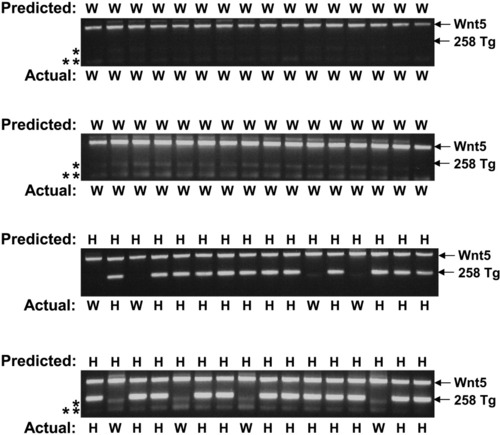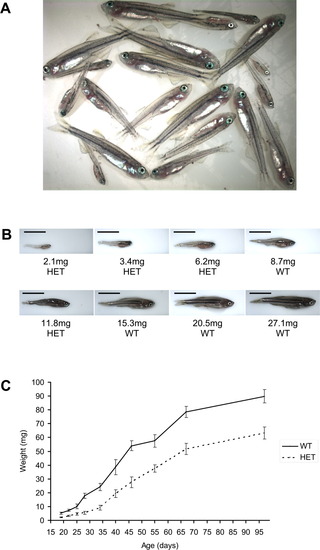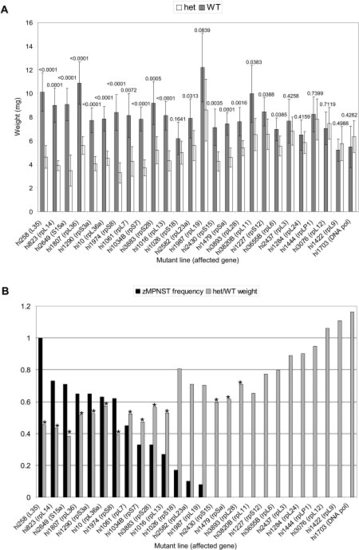- Title
-
Many ribosomal protein mutations are associated with growth impairment and tumor predisposition in zebrafish
- Authors
- Lai, K., Amsterdam, A., Farrington, S., Bronson, R.T., Hopkins, N., and Lees, J.A.
- Source
- Full text @ Dev. Dyn.
|
Heterozygous mutant embryos from the tumor-prone hi258 (rpL35) line are growth-impaired. One hundred twenty-two embryos from an outcross of a hi258 heterozygote were sorted into two groups by the presence or absence of a swim bladder at 4 days of age then further sorted by embryo length. The 32 largest, swim bladder-positive embryos were predicted to be wild-types (“W”), and the 32 smallest, swim bladder-negative embryos were predicted to be hi258 heterozygotes (“H”). Individual embryos were genotyped by polymerase chain reaction (PCR) revealing the presence or absence of the hi258 transgenic (258 Tg) band. Primers for Wnt5 were used concurrently to control for the efficiency of the PCR. Genotyping (“Actual&rdquo) revealed that the correct prediction was made in 32 of 32 wild-type calls (Chi-squared test, P < 0.0001) and 24 of 32 heterozygote calls (Chi-squared test, P < 0.005). *and **represent nonspecific background bands and primer-dimers, respectively. PHENOTYPE:
|
|
Heterozygous fish from the tumor-prone hi258 (rpL35) line are growth-impaired. A: The offspring of an outcross of a hi258 (rpL35) heterozygote, expected to be 50% hi258 heterozygous and 50% wild-type, are widely variable in size at 28 days of age. The fish were housed in a single tank. B: hi258 heterozygotes (HET) are generally smaller than their wild-type siblings (WT). Representative fish from the group depicted in (A) are shown with their weights and genotype. The weights of all fish in (A) are listed in Table S2. C: hi258 heterozygotes were outcrossed to T-AB wild-type fish, and their progeny were housed in the same tank. At selected time points, fish were weighed and genotyped. hi258 heterozygotes are significantly smaller than their wild-type siblings at every age examined. Error bars are ±2 SEM. Scale bars = 5 mm in each image. PHENOTYPE:
|
|
Heterozygous fish from high-tumor rp mutant lines are growth-impaired. A: Outcrosses of each rp line were performed, and their progeny were weighed and genotyped at day 25. White bars represent the average weight (mg) of heterozygotes (het) whereas gray bars represent the average weight (mg) of the wild-type (WT) siblings for each rp line; error bars are ±2 SEM. The P value (unpaired t-test) between heterozygotes and wild-type siblings is indicated above each set of bars. Lines are ordered along the x-axis by decreasing incidence of zMPNSTs. B: The growth defect determined in A, represented as the ratio of average heterozygote weight to average wild-type weight (grey bars), compared with the frequency of zMPNSTs (black bars), as determined in Table 1. The most highly tumor-prone lines appear to be the most severely growth-impaired. *indicates a statistically significant difference (P < 0.01 by unpaired t-test). Lines are ordered along the x-axis the same as in A for ease of comparison. PHENOTYPE:
|

ZFIN is incorporating published figure images and captions as part of an ongoing project. Figures from some publications have not yet been curated, or are not available for display because of copyright restrictions. PHENOTYPE:
|



